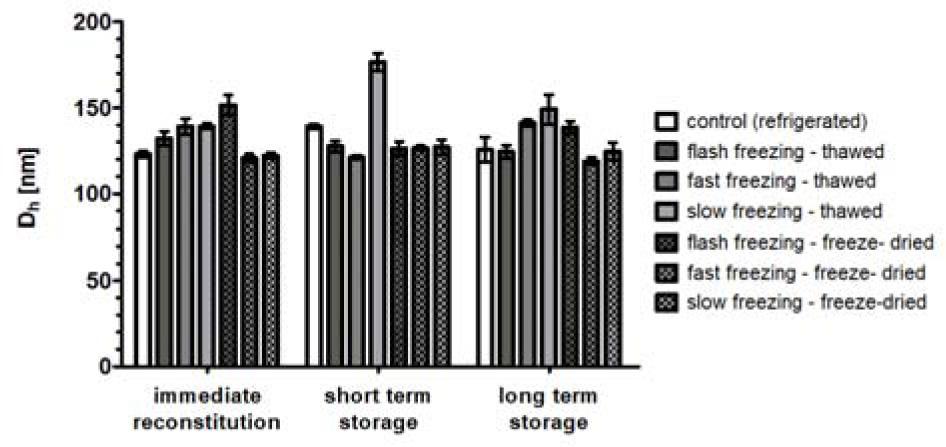Fig. 1

Fig. 2

Fig. 3

Fig. 4

Fig. 5

Details on the samples’ possible processing scenarios
| Processing, storage, and sample usage parameters | Options |
|---|---|
| Freezing conditions | Flash freezing (liquid nitrogen, −196°C) |
| Fast freezing (precooled freezer, −70°C) | |
| Slow freezing (precooled freezer, −22°C) | |
| Reconstitution strategy | Freeze-drying and redispersion |
| Thawing | |
| Stock storage period | Immediate reconstitution |
| 1-week storage | |
| 1-month storage | |
| Sample use period (after stock reconstitution) | Immediate measurement |
| Measurement after 1 week | |
| Measurement after 1 month |
Detailed description of various processing steps applied to the samples
| Flash freezing | Aliquoted samples were immersed in liquid nitrogen for at least 3 min, until visual inspection of samples confirmed full freeze. For prolonged storage, stock samples were moved to the precooled freezer (−70°C). |
| Fast freezing | Aliquoted samples were placed in −70°C precooled freezer for at least 12 h. For prolonged storage, stock samples were kept in the −70°C precooled freezer. |
| Slow freezing | Aliquoted samples were placed in −22°C precooled freezer for at least 12 h. For prolonged storage, stock samples were kept in −22°C precooled freezer. |
| Thawing | Reconstitution was realized by placing the stock sample at 4°C for thawing. The reconstituted sample was stored at 4°C for the whole sample use period. |
| Freeze-drying and redispersion | All stock samples, frozen in different conditions, after overnight treatment, were placed together in precooled freeze-dryer, at high vacuum, with a condenser surface temperature of −50°C, for 120 h. Stock samples in the form of freeze-dried cakes in conical tubes were vacuum-sealed and stored at 4°C until reconstitution. Redispersion was realized by adding 10 mL of ultrapure water to the cake and overnight moderate stirring at 37°C. Redispersed sample was stored at 4°C for the whole sample use period. |
| Stock storage period | Is considered to start when the processing of the particulate sample is completed, e.g., in the case of freeze-dried samples for redispersion – after completed lyophilization, and in the case of frozen samples for thawing – after samples are placed in the freezer. |